
First and Only Weekly Online Fanzine Devoted to the Life and Works of Edgar Rice Burroughs Since 1996 ~ Over 15,000 Webpages and Webzines in Archive Volume 4173 GORDON SCOTT |

First and Only Weekly Online Fanzine Devoted to the Life and Works of Edgar Rice Burroughs Since 1996 ~ Over 15,000 Webpages and Webzines in Archive Volume 4173 GORDON SCOTT |
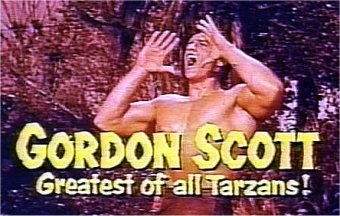
Thirteenth-century China was "a time of myth and mysteries, conquest and courage," at least according to the opening title sequence of 1962's Samson and the Seven Miracles of the World. The film's plot concerns Samson (not the biblical Samson, but simply a large and supernaturally strong man who has chosen to go by that name) rendering assistance to a group of Buddhist monks who are trying to restore the rightful emperor to power by taking on the Mongol horde and their leader, Garak, who threatens to subvert the process of bloodline sovereignty.
Samson, played by the American actor Gordon Scott, is not from China, but finds himself there in the course of his duties of wandering the earth and righting wrongs. The fact that he wanders a fully clothed earth dressed only in a pair of boots and tight orange high-cut shorts seems to attract little notice, although it may explain the conversion, at one point in the movie, of the evil and buxom Kiutai, who takes up Samson's side and is brutally whipped by Garak for her perfidy.
Along the way, Samson wrestles a tiger, uproots a tree, beats up a group of men with the support column from a tavern balcony, and, in the seventh miracle of the title (the last miracle at any rate--they do not total seven), manages to topple the Mongol palace despite being killed, shackled, and walled into a catacomb in the palace basement (in that order).
Despite the unorthodox locale, Asian extras, and sets left over from the production company's previous film, Marco Polo, Samson is an excellent example of the sword-and-sandals gladiator pictures churned out during the 1960s. It is the kind of movie Gordon Scott calls "a laugh," the kind he says you could make standing on your head. Scott made dozens of them, and for most people Samson and the Seven Miracles is largely forgettable. Scott will be better remembered as the 11th actor to play Tarzan, a role he filled in the mid to late 1950s, but for one fan, and eventually for Scott himself, Samson was a life-changing event.
Roger Thomas grew up in Baltimore but spent the summers in farm country--West Virginia, Pennsylvania, or Ohio. Thomas saw Scott play Samson at the Buckstown drive-in theater while his family was staying in Rogersville, Pa., in the '60s, and he never forgot it.
At the end of the movie, Samson looks directly into the camera. The hero, victorious, is asked, "Must you really leave us?"
"My task here is finished," he responds. "Destiny brought me here. Now I must go wherever there is a fight between right and wrong."
At least that's how it happens on the autographed videocassette in Thomas' collection. He remembers the line slightly differently: "Where will you go?" "Wherever I am needed."
Thomas is 62, with slicked-back hair, a neatly trimmed beard, and a pitch-perfect Johnny Cash baritone twang. He has a near photographic memory, particularly when it comes to movies. While it is possible that he has mistaken the line, it is more likely that the movie he saw as a boy, dubbed from the Italian, was a slightly different cut. Samson and the Seven Miracles has also appeared under the names Goliath and the Golden City and Maciste at the Court of the Great Khan, the second a nod to the original Italian version, in which Samson is, in fact, the stock Italian movie hero Maciste, a similarly large man of unknown origin, given to earth-wandering and wrong-righting.
Whatever the exact words, the intent is the same--boilerplate hero stuff--but the effect it had on Roger Thomas was undeniable. He became a fan of Gordon Scott. Decades later, after his hero came to live in the back bedroom of his South Baltimore rowhouse, Thomas asked him what the last line of the movie meant, and Scott told him, "I was talking to you. Didn't you know that?"
In its roots and in its meaning, the diluted term "fan" carries with it the sense of, if not exactly religious reverence, something close to it. From the Barry Manilow Fan Club to the Japanese otaku, the enthusiast looks to the heavenly star for something outside of everyday life. It is hero worship. It's girls screaming at the Beatles, or sleeping with the Rolling Stones. It's the autograph line outside the concert, the flash bulbs at the premiere.
F. Scott Fitzgerald wrote that the rich are different than you and I. Had he lived to see the current age of celebrity, he might have added that the rich are closer to us than the famous. The famous live in exotic places, behind high walls, and we pay men with cameras to spy on them. They are better than us, different from us, bigger than us. They don't work regular hours, they don't eat regular food, and they emphatically do not live in our back bedrooms.
Gordon Scott lived the life of the famous. He was admired by men, and women desired him. He traveled the world and he flew first class.
In a Baltimore County nursing home recently, Thomas tried to explain his admiration for Scott, who squirmed in his chair, unable to keep from interrupting. The trappings of Scott's fame were hidden away in the dresser of the room he shared with a stranger. It is doubtful that his nurses, or even his roommate, knew of his career on film.
Thomas: "All my life, he's been the inspiration for me. I used to spend my vacation time looking for him. I never did give up."
Scott: "This is a really sick man"
Thomas: "I'm proud to be that sick. He changed me, and I didn't turn out too bad. I used to work, make my money, go to the movies. All my life it's been Gordon Scott this and Gordon Scott that."
Scott: "Can you imagine trying to live up to that shit?"
Thomas: "They don't make them any better than that in my book. Nothing. They don't have anything better today."
Scott: "That's a great compliment, and no joke, Roger."
Thomas: "It's from the heart, old friend."
Later, after Thomas has left, Scott says this: "Roger is a marvelous guy. He's more than a fan--he's more like a friend or a brother or a son. He's a real nice guy."
According to the Internet Movie Database, Scott has starred in 25 movies, but when he looks over the list, he says, "They aren't all here."
Scott has played the heroes of mythology, from Samson (tag line: "The Mightiest of Them All!") to a founder of Rome (in 1961's Romulus and Remus). He has taken a few turns as Goliath (in Goliath and the Vampires and Goliath and the Rebel Slave). Scott has been Hercules, Zorro, Julius Caesar, and Buffalo Bill. He has been a gladiator (Gladiators of Rome) and a cowboy (opposite Joseph Cotten in Gli Uomini dal passo pesante, released in America as The Tramplers). He played a spy (Danger! Death Ray!) and a sheik (or a close relative, in Kerim, Son of the Sheik).
But to a generation of men who were boys (and women who were girls, or perhaps slightly older than girls) in the late 1950s, Gordon Scott is Tarzan, the larger-than-life ape-man whom he played in six films from 1955 to 1960, and whose picture appeared on posters and comic books around the world.
Gordon Scott isn't as big as he used to be, but then, almost no one is. In a recent series of interviews during a temporary stay at a Baltimore County nursing home, he dressed casually (though less casually than Samson), in sweats and a black-on-black Yankees cap, and sat in a wheelchair. As he spoke about his life, he pulled references from a wardrobe behind him--a book about the men who starred as Tarzan, an October, 1964 copy of Young Mr. America magazine featuring "Gordon Scott: Hollywood's King of the Muscle Men." At the height of his fame, he weighed 240, and stood 6-foot-2, but Gordon Scott was big even before he was Gordon Scott, when he was still just Gordon Werschkul, a German-American kid growing up in Portland, Ore., where he was born in 1927. He started bodybuilding when he was about 15--as soon as he realized it made him a hit with the ladies. "Vanity," he says, "is the crutch of us all."
When he was drafted in 1944, his size got him held back in basic training for five months while the Army special-ordered a uniform to fit him. All the other guys he trained with went into the old Rainbow division and off to fight and die on some Pacific island. "They're under the sand, now," he says. The uniform came in time for Scott to spend the tail end of the war training other soldiers in California and Texas. After he got out, he worked a variety of jobs, until someone noticed the big man working out at the Sahara Hotel in Las Vegas and asked if he wanted to manage the health club. He did, and "that was two and a half of the greatest years of my life," he says, a remarkable statement, given what was to come in 1953 as he worked out poolside at the hotel.
"I was out there working on the [diving] board," he recalls. "They had a three-meter board at that time, and I was out there working out on it. After I got out of the pool, this guy introduced himself, said he was an agent and wanted to talk to me. They were casting someone to be the new Tarzan, and he wanted me to come down and meet Sol Lesser, the producer. I said, `Sure,' you know, just for a lark. I didn't take it seriously at the time. We met Lesser on a Wednesday, we tested Friday and Saturday, and I was signed Monday."
The producers had already tested some 200 actors and athletes from around the world to fill the role of Tarzan. Gordon Werschkul, who had never considered acting, became Gordon Scott, the new hero of one of the most popular and long-lived action film series ever. ("Werschkul" was a little too close to Weissmuller, as in Johnny, still the best-known Tarzan actor.) Scott's first movie was filmed in the wilderness of a back lot at RKO Studios--the same one used for Gone With the Wind. "They had a little jungle fixed up out there," he says, "and we went out."
Tarzan's Hidden Jungle, released in 1955, was not a very good movie. Nor were 1957's Tarzan and the Lost Safari, '58's Tarzan and the Trappers (which began life as a TV series before being re-edited into a feature film), or Tarzan's Fight for Life, released the same year, but people liked Scott. His size helped him there, too--he did his own stunts, just because he could, and the filmmakers could get right in there for a closeup. The fight for life got a little too real when the script called for Tarzan to wrestle a huge python.
"It can get nasty if they grab onto you," Scott says. "You know, serpents have those teeth that slant back. It's hard to pull them off you. That was a big one, I think it was 19 feet, weighed about 200 pounds. But it was funny--they kept it in a warm box to make it kind of lethargic, so it wouldn't wake up, but they kept taking the shots over and over again, so it kept waking up a little bit more. By the time we got the shot, it was a really angry snake. But we got some good shots."
All four movies were produced by Sol Lesser. ("A cheap prick," as Scott remembers, "if you'll pardon the expression. I never liked him."). But the franchise, with Scott attached, switched hands in 1959, and Tarzan got a makeover.
"Sy Weintraub, he was the new producer," Scott says. "I wasn't the only one who thought [the movies were], you know, too homey, with the kid and Jane. Edgar Rice Burroughs wrote about the guy as a wild son of a bitch. [Weintraub] wanted to show that a little bit more."
The next Tarzan movie was filmed on location in Africa, and the villain was played by a pre-James Bond Sean Connery. Another difference was Tarzan's expanded vocabulary, beyond the "me Tarzan, you Jane" of previous films--a relief for Scott. That film, Tarzan's Greatest Adventure, and 1960's Tarzan the Magnificent are considered two of the best in the series. They were also Scott's last. He had offers in Europe for 10 films, and fears about getting typecast as Tarzan, so off he went. There were offers for more Tarzans, but he wasn't interested. He highballed them--said he would sign for $150,000, an unheard of price at the time, and would do only one picture a year. "I knew they wouldn't accept it," he says.
"If you're successful at [playing Tarzan], it ruins you for any other thing," he says. "Weissmuller was the same way. He was very successful at it, and he couldn't get arrested. It's like Superman-- Chris Reeve was great at that, and he worked at other things, but not a great deal, because he was tagged as that."
Europe was fun, anyway. His friend Steve Reeves was there, an old buddy from a gym in Oakland, Calif., where a group that included Reeves, Scott, and Jack La Lanne had worked out together in the '40s. Reeves had helped kick off a mythological frenzy in Italian cinema with his turn as Hercules in the 1958 movie of that name and the following year's Hercules Unchained. Hercules was joined by (and largely interchangeable with) Samson, Maciste, and another Italian strongman called Ursus, and the strongmen ruled the screen. It was the perfect place for a strongman/actor like Scott. Reeves brought him in for The Duel of the Titans, released in Italy as Romolo e Remo, in which the two played the twin founders of Rome. He made movies in Italy and elsewhere in Europe for most of the rest decade, deploying his 19-inch biceps in the pursuit of truth and justice. "A lot of body films, you know, sword and sandal," he says.
After running out of myths to adapt for the screen, Italian filmmakers set Hercules and company on anyone who could put up a fight, from vampires and pirates to moon men and the lost city of Atlantis, churning out low-budget sword and sandal pictures at a fantastic rate--between 1958 and 1965, the four big-name heroes appeared in more than 55 films.
The movies Scott and Reeves were in always involved the heroes invoking ancient gods, so Scott would needle Reeves, calling the big man up on the phone and when Reeves answered, Scott would boom, "By the gods!" Reeves hated that.
American companies specializing in dubbed and re-cut versions of Italian films also cashed in. American International Pictures, whose logo graces the credits of Samson and the Seven Miracles of the World, made its mark on the teen-trash-horror-exploitation genre in the '50s with films like Reform School Girl and Attack of the Giant Leeches, but also distributed hundreds of dubbed foreign films to the domestic drive-in market. Anything was fair game--American International brought to U.S. shores not only the off-brand Italian strongman Colossus in Colossus and the Amazon Queen but also Federico Fellini's La Dolce Vita.
The brief golden age of the strongman films ended around 1965, when poor box office receipts for the film Hercules, Samson, Maciste, and Ursus: The Invincibles showed that it was possible to have too much of a good thing. One of the writers credited on Scott's Romolo e Remo, Sergio Leone, would soon gain international fame for his work in the next big Italian-film fad--the "spaghetti western."
After the success of Leone's Dollars trilogy, beginning in 1964, the Italian film industry set its sights on the Old West. The line between the strongman pictures and the spaghetti westerns was only made bright by the heroes and costumes (some pitting, for example, Zorro against Maciste blurred even that). The plots and their comic-book morality transferred genres well, and so did Scott, with his rugged good looks and a physique that was impressive, yet not too large to be strapped into a cowboy outfit. Scott made a handful of westerns, including the film he considers one of his best: The Tramplers, with Joseph Cotten and Jim (look-alike son of Robert) Mitchum.
Being an actor, he says, "is one thing I'd never thought about doing, but once you're in it, it spoils you for anything else if you're successful at it. The money's so easy, you meet beautiful people. My god, that's the ideal situation--kind of a fantasy world. It's the best way to travel, too. First class, and you get to see a lot of interesting places."
And then, around 1966, Scott stopped making movies and returned to the United States. The reasons for his return are one of the few things he declined to discuss for this article. He had a personal matter to deal with, he says, and when it was over he had lost the desire to act.
The Tarzan films and the gladiator pictures lived on, in countless weekend television matinées, introducing new viewers, whether they knew it or not, to Gordon Scott. Danger! Death Ray! was satirized on Mystery Science Theater 3000. Scott hadn't seen it but says some of the parodies he'd seen making fun of his movies "were damn clever."
Roger Thomas never wanted to be in the movies--that's his wife Betty's thing. He just wanted to watch them.
"In my childhood, I had strict parents," he says. "I mean, super strict. You had to do everything by the code or you paid for it. I had to do all my chores and everything, to get my money, and I knew if Gordon Scott was playing Tarzan, I could see a guy--if I had him on my side, if I could be like that, they wouldn't do this, you know? You get beat up when you're a kid and you think, I want to be like that. Just the inspiration of it, you see him and, Man, I'm all right."
Thomas did a lot of bodybuilding himself as a young man, a lot of power lifting, and a bit of showing off. "Just a little strongman stuff," he says, "twisting iron spikes, stuff like that."
He worked at a commercial cookware manufacturing plant on North Point Boulevard, in Dundalk, handling the iron and steel. "In those days they had these big griddles, like on the stove over there," Thomas says. "They took the magnet lift to pick it up. I used to do it by hand. Then the guys I used to work with would bring me stuff and say, `Let's see you bend that.' I mean, they took this forklift--old forklift, it's called a Pettibone, from the '40s, and it was solid iron. They put it on a Fairbanks Morse scale, it weighs 6,700. Now, this was a photo published in, I believe it was 1968, in Muscular Development magazine. I lifted the entire side off the ground--tilted it over."
Thomas' strength got him jobs, but it was a mixed blessing. Everyone wanted him to bend something, lift something, or fight someone. "My arms used to get me the jobs," he says. "They'd say `You with the arms, come on.' After a while you learn it's not an advantage--it's a total thing against you. It'll kill you."
No matter how big Thomas got, though, he always remembered Samson, Tarzan, Goliath, and the man who played all of them.
"I'd be unloading tractor trailers on the docks, or just wherever, or handling the iron inside," he says. "And you've got 50 different people hollering at you at one time and, you know, you can only do one thing at a time--at the most. I used to think to myself, you know, I just wonder how Gordon would handle a situation like this. It's a little crazy sounding, but it just . . . well, maybe he would do this, and I would just handle it. He always told me, `Don't worry about nothing, just do the best you can.'"
Thomas may have wanted to meet Scott his whole life, but it's not like that's all he did. When he was 7, for instance, he wanted to meet the Three Stooges. When they appeared at Gwynn Oak amusement park, he snuck under the tent to see them. Security wanted to kick him out, but Moe Howard intervened. (Hey, if the kid wants to see us that bad . . .) And so, Thomas ended up at the table--there's Larry, there's Curly, with Moe sitting right here with his arm around him. Moe gave him a match pack (with the matches ripped out: "You don't need these, kid.") and he wrote on the inside, "To my pal Rog, from Moe Howard."
If Thomas still had that today, it would fit right in with his other stuff. Betty says he needs a whole other house to keep all that stuff--movies, artwork, knives, just about everything else. But nothing he would ever part with. Everything has a connection, a memory, a story.
Remember House on Haunted Hill? With Vincent Price? When Thomas was a kid, he told his mother that someday he would find that house, and he looked for it all over the place. He says he finally found it when his train caught fire outside of Barstow, Calif., going to Los Angeles.
"We were in the observation car," he says. "Me and Betty and a guy named Joe--an Indian, from up in L.A.--and I looked over and I see this big puff of smoke and flames shot out. I grabbed him and threw him down the stairs. I said, `Hold your breath.' He didn't. We end up in Los Angeles at the hospital at night. Now here, you're going to think this is weird, but I tell you, honest truth. I go out to get some air and I'm standing on Vermont Avenue. In my ear it sounded like this voice said to me, `Look, look, I'm here.' Right. I said to Betty, `Will you do something with me tomorrow? Now I know this is going to sound crazy, but ride down to Vermont Avenue with me.' She said, `Why?' I said, `Because I just want you to.' We got down there, looked up, there's my house. I was a guest seven times in that house, so I accomplished that, too."
His greatest non-movie-related accomplishment is likely marrying Betty, an actress who has appeared (under the name Betty Willey) in around 40 films and TV shows, mostly in small roles, beginning with a part as a cop in John Waters' 1990 Cry-Baby. Sometimes, people don't believe Betty has been in as many films as she says, so she brings pictures. That's her with Johnny Depp, her with Adam West. Waters, with whom she has worked in several films, is her favorite director, and she has appeared in Homicide, The Corner, and The Wire. She has run a karate school and been a champion swimmer. For one movie, Dead Laughing, she had to claw her way out of a grave dressed as a zombie bride. She came home in costume and surprised Roger, who was standing at the window. "I turn around," he says. "And there she is--in full makeup, with blood dripping. I almost knocked her clear through the wall. I said, `You didn't come home like this?', and she said, `Yeah I did.' I mean, it was gruesome. Your first instinct is either to jump out the window or let her have it.
"There were never two more adventurous souls, I think, than her and I at one time," he says.
They orbited the same circles around Baltimore for years without meeting--his friend dated her sister, he and his dad helped her parents out after a car accident one day--and then one night in 1984, she came into the grocery where he was working. She was dressed for work in her nurse's uniform, and she was mad. Someone at the store has accused her brother of stealing. Roger smoothed things over (it was the guy behind the meat counter). As he walked her to the door he said, "You look like you could use a hug." And she said, "Yeah. Can I have one?"
People called them Romeo and Juliet, and on rainy days they would get together in the lobby at Johns Hopkins Hospital, where she worked, and sit and talk about how one of these days Roger would take her to Hollywood, and all the things they would do and the people they would meet, not thinking for a second that any of it would happen. But then Betty got a part in A Christmas Carol at the Fells Point Corner Theatre, and then came Cry-Baby. She would take just about any role that came along, flying out to Hollywood to meet people and audition, and while Betty was looking for work, Roger was looking for Gordon Scott.
After Scott stopped acting, he toyed with the idea of writing a book about his life. "I figure everybody gets one book," he says. But the notes and journals he had been keeping for years were stolen during his travels. "Why they would do that, I don't know," he says. "But it was a great loss to me. All the things I remembered. That kind of broke my back."
He joined up with the autograph show circuit--appearing at fan conventions in California, Florida, and points between, making paid appearances to sign memorabilia--often with his old friend Steve Reeves. In late April 2000, they were both scheduled to appear at an autograph show in California. "I called him and told him I was going to get there two days early," Scott says. "He said, `I'm not feeling too well.' Five days later he was dead. Just like that. Never drank or smoked or any of the stuff that usually kills at that age. That was a kick in the head. Goddamn it. Good guy." Reeves was 74.
Meanwhile, it seemed like Thomas kept missing Scott wherever he went--he would be in a collector's store in Hollywood looking through pictures of Scott, and the shop owner would say the actor had just been in.
"Over the years of looking for him, it was just a little challenge," Thomas says. "I just wanted to walk up to him and say, `Hey, I'm probably your biggest fan that ever was, I just want to shake your hand one time.'"
It took about seven years of trips to California, and a tip from Edgar Rice Burroughs' grandson Danton -- whom Thomas had met through collecting circles, and who knew that Scott was staying with a family in Arizona -- to get a phone number, but Thomas was nervous. "I really didn't know what I was going to say. I had no idea. I didn't want to sound too . . . you know, you're babbling, you feel like a child, sometimes."
When he dialed the number, he settled on, "Hello, Mr. Scott, I'm Roger Thomas from Baltimore, Maryland. And I'm probably the biggest fan you've ever had in your life."
"Really?" Scott responded. "You know, you don't hear that much anymore."
The two men began a correspondence. Thomas sent gifts for birthdays and Christmas, tracking down Scott's rarer films for him. Scott wanted to do something for Thomas in return, but Thomas told him, "No. All my life from when I was young, you gave me everything I needed, for real." He says Scott told him, "You know, I believe you are what you say you are."
About a year after Reeves died, things weren't working out for Scott in Arizona. He had been living for years on money from his autograph shows and other appearances, along with residual payments from his films. He decided to take Roger up on his offer of a visit to Baltimore.
Thomas still remembers that Scott flew into BWI for their first face to face meeting on March 16, 2001, at 6:20 in the evening. And there it was, after all those years, that Roger Thomas from Baltimore was finally going to meet his idol, and the idol would meet his No. 1 fan. Scott had flown halfway across the country to meet Thomas, who had a friend drive him to the airport.
And they missed each other.
Thomas: "Being stupid, I didn't have a sign that said `Gordon Scott,' and I'm standing there like a boob, and they brought him out in a wheelchair. I must've had my back turned."
Scott: "He's running up and down saying `Have you seen Gordon Scott?' `Have you seen Gordon Scott?'"
Thomas: "`What's he look like?' Well, if you see him, you'll know the man. For God's sake, he's Tarzan!"
When he finally found him, the actor was at a bank of pay phones, trying to get ahold of someone to pick him up. After all of Thomas' planning, the first words his hero spoke to him in person were "It's about damn time." Thomas was so excited he forgot his ride at the airport. They took a cab home.
"I came out here to visit Roger and Betty," Scott says. "And while I was out here it turned into an extended stay, because I had a good time. I hadn't lived on the East Coast and I wanted to see what it was like. I came out for a couple of weeks and I stayed for years."
In fact, Scott stayed with them for almost six years, sharing the Thomases' South Baltimore house with their dog Babe and two large tropical birds. Scott spent most of his time in his room, reading books Roger got from the nearby library. The trio took their meals together, watched movies together, and Scott gave Betty pointers on her acting. "Most of the time, he was a recluse," Roger says. "He liked his privacy and that was it."
They talked about Scott's films--Roger's enthusiasm for the minute details was boundless. During a visit to Scott in the nursing home, Roger came through the door bursting with news.
Thomas: "Guess what I have for you? Your rarest, unattainable movie, The Son of the Sheik."
Scott: "We shot that at King Farouk's, before he went out of business."
Thomas: "You had that horse [in The Tramplers], an Arabian, wasn't it?"
Scott: "I wanted kind of a rangy horse, that Frederick Remington used to draw--all bone and sinew--and I got him. And he could run like hell."
Over the course of his residence in the Thomas household, Scott gave Roger many of the things he kept from his movies--the coat he wore in The Tramplers, for example, and the golden sheath knife the studio gave him when he retired from the Tarzan franchise. The knife is one of Roger's most prized possessions, and he becomes visibly emotional while speaking of it.
Roger says Scott was depressed a lot, believing people had forgotten him. At the same time, however, he refused offers from movie producers, fans, and journalists who tried to reach him through the Thomases. After Scott went into the nursing home, Roger was worried for his friend and began reaching out to the people who had been asking for Gordon Scott.
Scott entered the nursing home for rehabilitation of what he said in February was "trouble with the upper respiratory. Physically, I'm fine. I don't have any aches or pains--it's just my breathing." He expected to be out in a few weeks.
Roger and Betty were Scott's only regular visitors at the nursing home. He has children but declined to discuss them for this article, saying only that they were grown and have their own lives to live.
Scott hadn't done anything to publicize his address at the nursing home, and did not admit many visitors, but during a visit in February he had received a few fan letters anyway. He pulled them out of his wardrobe.
"This is 50 years after--these people are in their 50s and 60s," he said. "I used to get 12 and 15 a week, maybe 5,000 after an opening. And really, very embarrassing to read--nobody's really that good.
"It can turn your head if you're not laughing too much, but they're sincere, and I appreciate that," he continued. "They're good people, and they hit every phase of life as we know it--from the very wealthiest to the dead poor--but that Saturday morning, or the other days, they went to see it and it got them out of the house. And they enjoyed it. So you know, you contribute something to the general population. It's not like building any great discovery or anything, but it's just . . . doing a job well, and people enjoy it, and that means a lot."
While Scott was at the nursing home, he received a visit from Sky Brower, a fan from Arkansas who runs one of the many Tarzan fan sites on the internet. Brower had been trying for years to track down the actor and had written a letter to the Thomases' address. The letter went unanswered. Brower tracked down a phone number and spoke to Betty, but didn't get through to Scott. When Brower heard that Scott had gone into a nursing home, he tried again, and coordinated a visit to Baltimore.
With money raised from Tarzan fan sites, he bought Scott copies of several of his movies, an LCD television, and a DVD player. When Brower posted the story of his visit on his web site, inquiries about Scott's health began coming in. Two of Scott's leading ladies from his Tarzan films have since written to Brower. For his part, Brower wrote in an e-mail that "the time spent with this great man will remain one of my most special memories."
The day after Brower visited in February, Scott went into the hospital--first Good Samaritan, for some swelling in his legs, then to Johns Hopkins for a series of heart surgeries.
At Hopkins, the Thomases had trouble getting information on about Scott's condition, but Betty talked her way in. As of April 27, she reported, he was unconscious about 90 percent of the time and was being fed through a tube. A few days before, the hospital had asked the Thomases whether or not to put Scott on life support. They told the hospital yes, but the responsibility wore heavy on them. They were afraid of doing the wrong thing and had been unable to locate any members of Scott's family. Roger had tried to ask Scott what they should do in the event of his death; Scott never wanted to talk about it.
On the morning of April 30, as this story was being prepared for press, Betty Thomas called to say that Gordon Scott had died. He was 79 years old. Roger Thomas was too upset to come to the phone.
Back in February, while Scott was still in the nursing home, he kept the television on, always tuned to black and white movies.
"I like the old ones," Scott said. "They have that Turner Classics--some of the foreign language things I really like. You see some of the really great ones, too. They're great entertainment, and they're a companion--in a place like this particularly.
"Everyone has to have that--to get away from what they're doing and to be transported to a place, whether it's intellectual or just going to the funny farm. It's something that's comparatively cheap to do, and you get great enjoyment out of it. When a film comes on, I don't try to analyze it, although subconsciously that happens anyway. I don't say, `Well, how did they do that background or get that shot?' Bullshit. I get into the story, and sometimes the photography is so beautiful. I'm a fan
CAN'T SWING A DEAD CAT: Gordon Scott wrestles a tiger in Samson And The Seven Miracles Of The World, one of the dozens of Italian sword-and-sandals movies he made in the 1960s.
STEEL TOOTH: Scott as Tarzan, the role for which he is best known.
TALL, DARK STRANGER: Scott Considered 1966's The Tramplers, one of the few westerns he made, among his best films.
MORE THAN A FAN: (above) Betty And Roger Thomas took Scott into their South Baltimore home; (below) Scott and Thomas in Scott's bedroom in 2002.
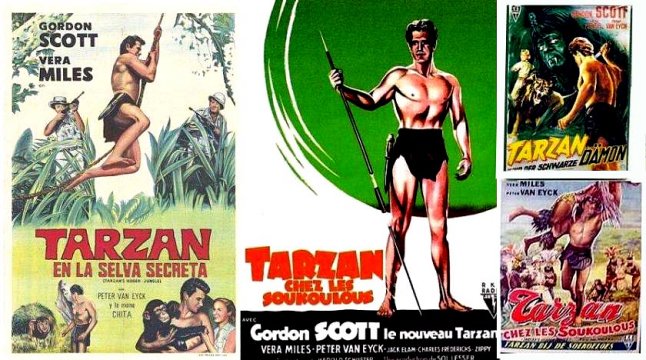
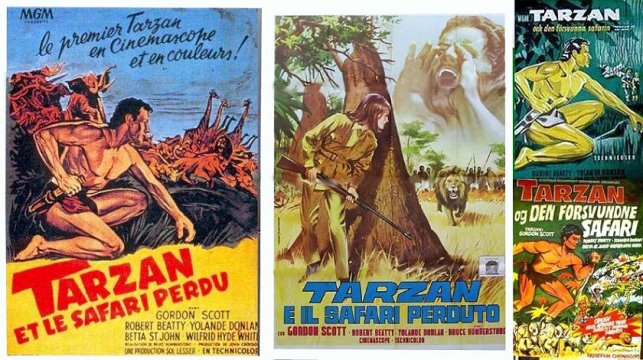
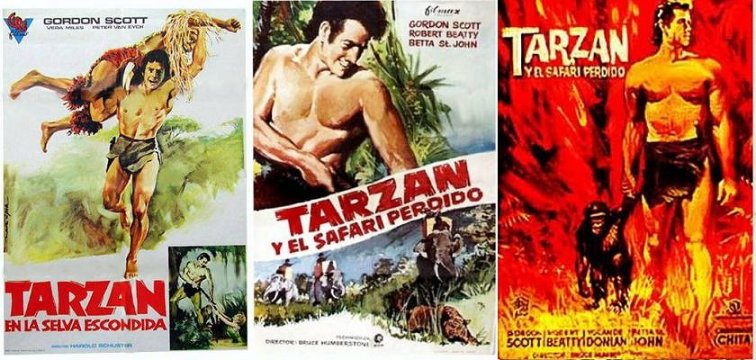
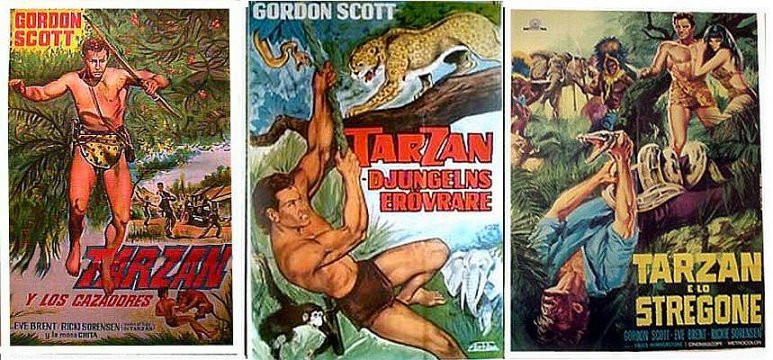
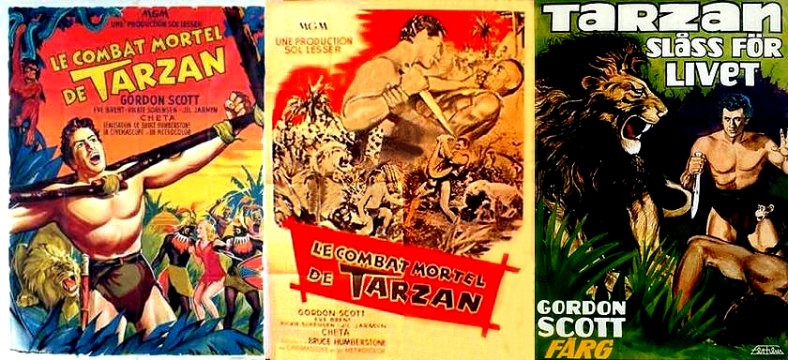
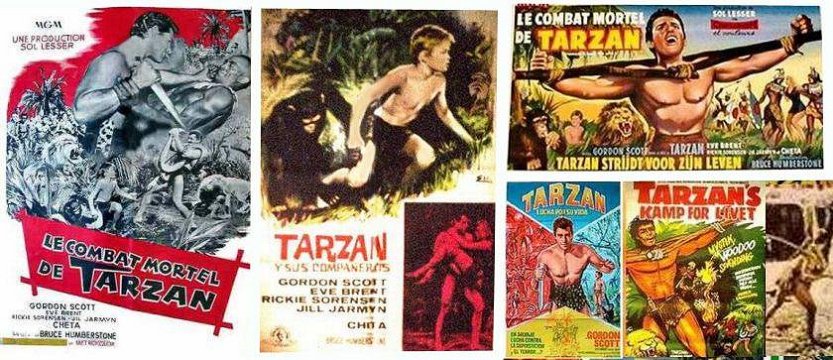
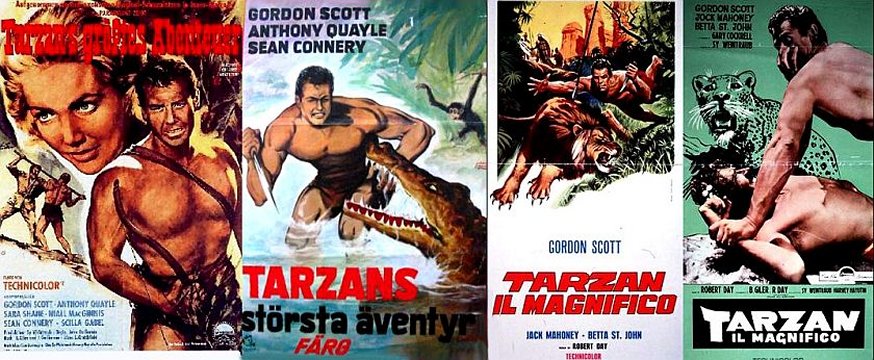
![]()

1926-2007 Memorial |

Biography Filmography |

Gallery 1 Dell |

Gallery 2 Tarzan Stills |

Gallery 3 Foreign Stills |
TARZAN FILMS STARRING GORDON SCOTT
|
Hidden Jungle  |
and the Lost Safari  |
Fight For Life  |
and the Trappers  |
Greatest Adventure  |
the Magnificent  |

BILL
HILLMAN
Visit
our thousands of other sites at:
BILL
and SUE-ON HILLMAN ECLECTIC STUDIO
All
ERB Images© and Tarzan® are Copyright ERB, Inc.- All Rights Reserved.
All
Original Work © 1996-2013/2019 by Bill Hillman and/or Contributing
Authors/Owners
No
part of this web site may be reproduced without permission from the respective
owners.